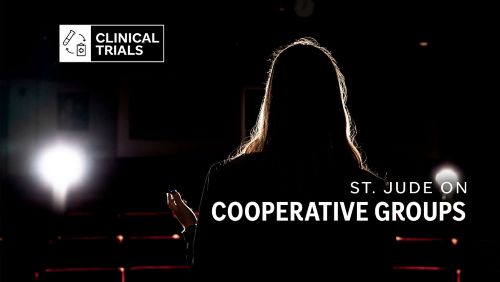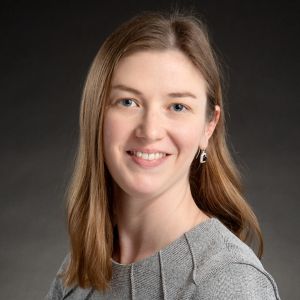St. Jude Family of Websites
Explore our cutting edge research, world-class patient care, career opportunities and more.
St. Jude Children's Research Hospital Home

- Fundraising
St. Jude Family of Websites
Explore our cutting edge research, world-class patient care, career opportunities and more.
St. Jude Children's Research Hospital Home

- Fundraising
Strength in numbers: Cooperative group clinical trials move the needle against pediatric cancer

Through cooperative groups many different institutions can work together to run the same clinical trial protocol, propelling the care and treatment of pediatric cancer and sharing results through papers and presentations that help advance the entire field.
No single investigator is going to cure childhood cancer. Research is, at its core, a collaborative endeavor that requires expertise in different fields to capture a holistic picture of biological events, from proteins to whole organ systems. This remains true in clinical research where not only are multidisciplinary investigators essential, but patients and their families play a central role in making discoveries.
While cancer is the second leading cause of death in children, considered all together, childhood cancer is a rare disease. According to the National Cancer Institute, two million people will be newly diagnosed with cancer in the United States (U.S.) in 2024. In children, there will be approximately 16,000 new cancer cases in the U.S. this year. Running a clinical trial requires enough patient participants to gather robust data so that researchers can draw appropriate conclusions from what they observe. Recruiting enough participants is hard to do for a disease that occurs in limited numbers, where the patients may be scattered in many different locations.
To address this problem, the childhood cancer research community came together decades ago to create cooperative groups to enable the study of novel treatments. Many institutions band together through these cooperative groups to implement the same clinical trial protocol. By doing so, patients can enroll in the same study with the same guidelines and requirements but at different locations. These large multi-site cooperative group clinical trials allow a greater number of patients to participate in research and can also speed up discovery by achieving full trial enrollment more quickly.
St. Jude has a long history of leading and participating in cooperative group clinical trials. Investigators, including Julie Park, MD, Department of Oncology chair, and Sara Federico, MD, Department of Oncology, Solid Tumor Division director, are leaders in neuroblastoma research and care. Each approaches the disease through different studies and collaborative group work.
The need for novel therapies in neuroblastoma
Neuroblastoma is a solid tumor that arises from cells of the nervous system. These tumors can develop anywhere from the neck to the pelvis, but they most often begin in the nerve tissue of the adrenal gland, which is located on top of the kidneys. Neuroblastoma is usually found in children younger than 5, and it is the most common solid tumor found outside the brain in children.
In the U.S., about 700 children are diagnosed with neuroblastoma every year. Approximately half of these patients have high-risk disease and receive aggressive treatment, including surgery, high-dose chemotherapy, stem cell transplantation, immunotherapy and radiation.
“Although new treatments, evaluated through successful clinical trials, have led to improvement in survival over the past two decades, unfortunately many patients still die from their disease, and novel therapies are desperately needed,” said Federico.
Working with the Children’s Oncology Group on a phase III trial
The Children’s Oncology Group (COG) is the world’s largest organization devoted to childhood and adolescent cancer research – uniting more than 10,000 childhood cancer researchers at over 200 hospitals, universities, and cancer centers. Until 2019, Park served as chair of the COG Neuroblastoma Disease Committee.
Through COG, Federico is leading a phase 3 clinical trial for neuroblastoma. A phase 3 study compares a new treatment approach against the standard of care to confirm which is more beneficial to patients. These studies often enroll many patients and are the final step before seeking Food and Drug Administration (FDA) approval for a new treatment approach.
“The cooperative group plays a critical role in advancing science and the cure rates of patients with pediatric cancer,” Federico explains. “It allows investigators to ask critical questions that often need many patients across a diverse population to answer.”
The study is evaluating whether the addition of a monoclonal antibody drug called dinutuximab to the beginning of therapy will improve outcomes compared to the standard of care in the treatment of newly diagnosed high-risk neuroblastoma. Dinutuximab binds to a molecule called GD2, found on the surface of neuroblastoma cells but not on most of the healthy or normal cells in the body. By binding to neuroblastoma cells, the antibody helps signal the immune system to kill the cancer cells.
The case for using an anti-GD2 antibody for the treatment of neuroblastoma builds on a tremendous body of prior work. This includes results from a phase 2 clinical trial using an anti-GD2 antibody manufactured at St. Jude in combination with chemotherapy (chemoimmunotherapy), which published in the Journal of Clinical Oncology in 2021.
“The success of chemoimmunotherapy has led to a paradigm shift in how we treat patients with relapsed disease,” Federico says. “It has been a true game changer for this patient population. The question now is whether chemoimmunotherapy will lead to a paradigm shift in how we treat patients with newly diagnosed high-risk disease.”
New Approaches to Neuroblastoma Therapy consortium drives change together
In addition to clinical trials through COG, patients with neuroblastoma can also enroll in clinical trials run through the New Approaches to Neuroblastoma Therapy (NANT) consortium. Park is the current scientific chair of NANT, established in 2000 as the only international clinical trials consortium focused solely on developing new treatments and biomarkers for relapsed and refractory high-risk neuroblastoma. NANT sites enroll patients and collect consistent data to provide a rationale for larger consortia trials, such as COG studies.
Park got involved with NANT early in her career as a clinical researcher, working at Seattle Children’s Hospital. A P01 grant from the National Cancer Institute funds NANT. The idea is that by partnering laboratory investigators with clinical researchers, the consortium can take scientific findings and build early-phase clinical trials to help identify novel therapies for children with high-risk neuroblastoma.
“Our hope is that many of our trials will come directly from the laboratory investigators on the P01, who are working to uncover both molecular and immunologic vulnerabilities so that we can better target neuroblastoma,” said Park.
NANT has played a role in many of the most recent advances in neuroblastoma care, including testing the safety and efficacy of lorlatinib, a targeted therapy for neuroblastoma harboring ALK gene aberrations.
Having a cooperative group dedicated to early phase clinical trials adds unique value to the field of pediatric cancer research. “Understanding how to develop trials that are accessible, how to get therapies to patients faster — that’s the place for NANT, to get the initial data, and do the correlative analyses that really can’t be done in large cooperative group trials so that we learn as much as we can from every patient,” explains Park.
Working together for a brighter future for patients
By participating in and leading cooperative group studies, investigators at St. Jude, including Park and Federico, are driving change for patients with high-risk neuroblastoma. These studies accomplish what no one investigator or institution could do alone — bringing the latest scientific findings into the clinic and shepherding them through the early phase 1 and phase 2 studies so that they can reach large phase 3 trials.
“The word cooperative by virtue says it all,” says Park. “This work has to be collaborative; working together enables these studies to have so much impact.”






